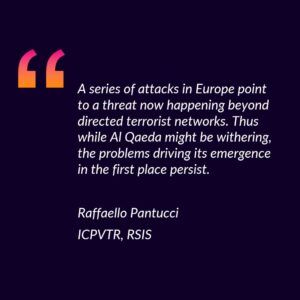Raffaello Pantucci

RSIS Commentary is a platform to provide timely and, where appropriate, policy-relevant commentary and analysis of topical and contemporary issues. The authors’ views are their own and do not represent the official position of the S. Rajaratnam School of International Studies, NTU. These commentaries may be reproduced with prior permission from RSIS and due recognition to the author(s) and RSIS. Please email to Mr Yang Razali Kassim, Editor RSIS Commentary at RSISPublications@ntu.edu.sg.
SYNOPSIS
The reported passing of more of Al Qaeda’s senior leadership marks the almost complete passing of a generation. Yet a series of attacks in Europe point to a threat now happening beyond directed terrorist networks. Thus while Al Qaeda might be withering, the problems driving its emergence in the first place persist.

THE REPORTED deaths of Ayman al Zawahiri and a number of other senior Al Qaeda figures suggests we are approaching the end of an era. At the same time, a series of events in Europe point to a terror threat that remains as ingrained and dangerous as ever. None of this is about the persistence of Al Qaeda and ISIS-affiliated groups around the world.
These parallel sets of events illustrate the reality that terrorist groups are not the ultimate problem in themselves, but are an articulation of broader societal issues. The core group may be withering, but the problems driving their emergence remain.
Other Fires Burn, Different Set of Problems
Much like their initial emergence, Al Qaeda’s senior leadership’s slow disintegration has been shrouded in mystery. The deaths of Abu Muhsin al-Masri (Husam Abd-al-Rauf) in Afghanistan, Abu Muhammad al-Masri (Abdullah Ahmed Abdullah) in Tehran and the possible passing of leader Ayman al Zawahiri have all taken place off stage.
Some, like Abu Muhammad’s dramatic shooting in Tehran, seem cinematic in their drama. Others, like Ayman al Zawahiri’s possible passing, suggest a quiet exit. But this series of deaths leaves very few men standing amongst the initial cohort who assembled around Osama bin Laden as he launched his jihad against the West.
Yet as this light dims, other fires burn. Around the world, Al Qaeda or ISIS-affiliated or -inspired groups continue to operate; but they now have turned inwards on their local contexts, focused on whichever regional struggle they have emerged from. Global goals now seem secondary priorities. And in the West a very different threat troubles security forces.
The spate of attacks and plots that Europe has seen over the past few months illustrate a different set of problems. Not the large-scale terrorist attacks of 2001, but rather a constant patter of rage articulated through pin-prick attacks. And there is no connection to Al Qaeda in any of these attacks.
Some jihadi strategists would argue that this is the fulfilment of the vision laid out by one of their visionaries, Abu Musab al Suri, who wrote at length of a global insurgency made up of attacks and cells with no direct link to each other but all driven by the same aim and goal.
Yet the seeming incoherence of the attacks and their planning suggest otherwise. Few of the attackers seem driven by genuine belief, more often are stirred by personal or confused rage which they have attached to a jihadi ideology. None show a tangible link to the initial core of Al Qaeda, and in many cases, show little link to some of the group’s many subsequent expressions.
Al Qaeda’s heir ISIS seems to be the most effective at connecting and inspiring this new generation, but there is very little evidence usually of cases having specific direction and planning organised by the group.
The Disentangling of Two Threads
The most recent European case, carried out by a woman who started stabbing at passersby at a shopping mall in Lugano, Switzerland, appears to be have been done by someone who wanted to connect with ISIS but failed to. She tried to go to Syria in 2017 and failed.
The earlier attacks this year in Europe appear equally uncoordinated – some (like in Austria) show links to networks around ISIS, while others (like the young man who decapitated a teacher in Paris suburbs) show no clear links to groups, but a deep personal rage that was seeking an outlet. But it is unclear that ISIS directed any of them.
Rather than seeing the realisation of a plan set in motion by Al Qaeda, we are seeing the disentangling of two threads. On the one side, an organisation that launched a war is being eradicated, while on the other a series of tensions in Europe (and elsewhere) are articulating themselves through a terminology articulated by the group.
The many expressions of Al Qaeda will not go away, but the core organisation is no longer able to project its power and force in the same way. A continuing disintegration will take place as the various groups using the name around the world continue to focus their attention on local conflicts rather than the global clash the core group was advancing. Their language will remain the same to give them gravitas, but their interests will likely stay local.
Deeper Issues Must Be Addressed
ISIS and Al Qaeda successors and affiliates will continue to want to strike at the West, but are unlikely to dedicate too much resource towards realising these goals. Years of successful security force penetration and management have likely dampened their enthusiasm, though they will continue to look for opportunistic moments and individuals to take advantage of.
At the same time, the divisions and cultural clashes in Europe and elsewhere will remain and likely worsen. A rising extreme right in Western societies reflects how anger at difference in society in the West in particular is deepening. The repeated attacks by militant Islamists we have seen in Europe show that a deep anger amongst Europe’s Muslim community persists.
The targets they chose are ones which reflect a desire to strike society in its every form. The manner of attack they choose is clearly inspired by Al Qaeda or ISIS, but there is very little evidence of a direct link. Nevertheless, these attacks will stir the extreme right further, exacerbating circular tensions and deepening divisions.
The passing of an earlier generation of jihadists is not the end of the problem. It is the end of an expression of a problem. The deeper issues which Al Qaeda and other jihadist groups fed off in the first place to grow remain. And until these are addressed, the world is likely going to continue to see a steady patter of incidents. The difficulty will come in ensuring we are focused on managing the right expressions of the problem, and not making these tensions worse.
No comments:
Post a Comment